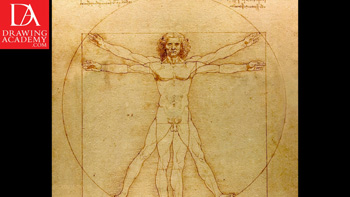Drawing a Girl – Copying the Old Masters
Video Lesson Description
In this “Drawing a Girl” video lesson, you will discover how you can improve your drawing skills by drawing a girl portrait.
Drawing a Girl – Making a copy
In this video, I do not intend to make an extremely accurate carbon copy of the original drawing by Leonardo da Vinci. In fact, I have intentionally changed some outlines of the girl’s head and hairstyle. You can see that my outline of the girl’s neck is just a single line instead of several lines, as done by Leonardo.
Leonardo’s style of metal-point hatching is very precise and delicate on the girl’s face, and yet, is quite loose on her hair, neck and shoulders. It is as if the Master is saying, “What a beautiful face with an intricate pattern of light and shade on her skin; yes, her hair and shoulders have some shades as well.” He uses broad, straight strokes for her neck, hair and shoulders.
Drawing a girl, I use light pressure pencil strokes for the delicate shades on the girl’s face. The direction of my strokes follow the Master’s left-handed style.
Art historian, Helen Gardner, says that, “His mind and personality seem to us superhuman, the man himself mysterious and remote.”
Despite less than 20 of his paintings having survived, he is considered as one of the most talented painters of all times. The well-known paintings by Leonardo da Vinci include the Mona Lisa, which is probably the most famous portrait in the world, and The Last Supper, which is the most reproduced, religious painting of all time.
Many more of his drawings survived to this day, including the one we are making a copy of now.
One of the most recognized drawings by Leonardo is the, Vitruvian Man. In the Drawing Academy video on Golden Ratio, I present this drawing as an example of the various golden proportions found by Vitruvian and illustrated by Leonardo.
Leonardo took an interest in almost every applied field imaginable. Numerous sketchbooks he produced illustrate his studies and inventions in civil engineering, human anatomy, optics and hydrodynamics … to name the few.
Many inventions by Leonardo were not even feasible with the technologies available at that time. He conceptualized a helicopter, a tank, concentrated solar power and a calculator.
Drawings by Leonardo da Vinci are taking a special place in the history of art. He was a very productive sketcher, making numerous journals with more than 13 thousand pages filled with notes and drawings. Here are some ideas we can learn from this man when it comes to making sketches:
– Make multiple sketches of the same object from various points of view. Leonardo often did four or five images of the same item or body part – depicting it in various positions and often slicing it in half to reveal the inner construction of the object.
– Draw an object in different perspectives; this will help to represent its three-dimensional nature.
– Draw an object in different states and stages of development. For example, this page with sketches of flowers shows some with leaves while others without, also some are budding, while other flowers are full grown.
– You may also annotate your sketches about the subject of the drawing and a task you want to accomplish. Such annotations can be very helpful for you later and for others to fully understand your creation. Here is one of Leonardo’s sketchbooks I took a photo of in the Victoria & Albert Museum in London. It is filled with annotations to his sketch.
– Employ your imagination for sketching ideas in addition to drawing from nature or a model. Leonardo’s curiosity helped him with multiple inventions. He was curious about flying, so he conceptualized prototypes of: a parachute, a helicopter, a plane and a glider.
– Look for solutions provided by nature in search of new ideas. For example, Leonardo’s glider resembles a bird’s wing construction.
Leonardo da Vinci is one of my favorite fine artists. He is much more than just an artist. His thinking and inventions, revealed in numerous sketchbooks, show the spirit of scientific curiosity and mechanical inventiveness that were centuries ahead of his time.
He used his superb intellect, unusual powers of observation and mastery of the art of drawing to study nature itself. This was a line of inquiry that allowed his dual pursuits of art and science to flourish.
Leonardo da Vinci was driven by an unlimited desire for knowledge, which guided all his thinking and behavior. His artistic talent helped him to convey ideas, knowledge and inventions. His example must inspire us all to keep practising the skills of drawing and to be able to express our thoughts in visual form.
Our copy of Leonardo’s, Portrait of a Girl, is almost finished. I do not pretend this sketch is even close to the effortless perfection produced by the Great Master. However, it was a pleasure to draw a copy of his drawing. I feel privileged and grateful for this experience.
Great art starts with great drawing. Only practice will perfect your drawing skills.
- Receive 15 new videos monthly (45 in total)
- Incredible discount – $4,164
- Bonuses - Fine Art eBooks and Videos
- Drawing Academy Diploma of Excellence after course completion in 3 months
- Personal coaching by Drawing Academy Tutors
- Lifetime membership. Free after the 3rd month
- Immediate access to all 45 video lessons
- Incredible discount – $4,198
- Bonuses - Fine Art eBooks and Videos
- Drawing Academy Diploma of Excellence after course completion in 3 months
- Personal coaching by Drawing Academy Tutors
- Lifetime membership. No more payments



